Report by Tabassum Bachoo
25 December 2006 - 30 December 2006
The phone rang on Friday 15 December 2006 with a request to go to India to conduct Teacher training for Primary School teachers the following week! Having accepted the challenge and with two days to pack and prepare after the end of the school autumn term, I flew out the following Saturday 23 December, joined on the flight from Dubai by Sister Selina Kassamali, who was to conduct the Secondary School inset training.
We arrived in Bangalore and were met by Mirza Mehdi Saheb, who is the President of the Imamia Education and Welfare Trust which runs the Zainabiya School in Alipur. We were guests at his home that night, and he briefed us on some details of the school.
We left for Alipur the following day joined by Brother Muzammil Hussain, and were welcomed by staff and pupils. They made every effort to make us feel at home throughout our entire stay.
The aim of this visit was to assess the teaching and learning in the Alipur Zainabiya School and make recommendations of areas of need to inform a future programme of training to meet these needs. Teachers from the Karimpur Zainabiyya School and the local government school would also attend the Inset training sessions.
FOCUS: PRIMARY SCHOOL
1. General Impressions of the School
The first impression one gets of Zainabiyya School, Alipur is one of tranquillity and peace. There is a tangible sense of positive energy infusing the school, with staff and students working industriously and with dedication to enable learning to take place.Children greet you with smiling faces and impeccable courtesy which is a delight. Staff and pupils seem to form part of one big family.
| The Alipur school teaches using English Medium and the Karnataka syllabus. Classes range from LKG (4 years) to PUC (A’ Level equivalent – 18 years). It has a total of 595 students (Primary 416 students – LKG to Standard 5; Secondary 179 students – Standard 6 to PUC). |
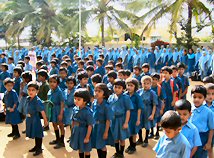 |
The school is currently co-educational to standard 7, with 460 girls and 135 boys, but will become a single sex girl’s school from next year.
Class sizes are generally larger than in the UK, with a maximum of 49 students in Standard 4. LKG classes work on 2 shifts - morning and afternoon with a combined total of 52 students. Secondary numbers are generally smaller with 21 students in Standard 10.
Many of the parents are illiterate and do not understand the importance of education or are unable to support their children practically in their studies. The number of girls in secondary school falls when they reach Standard 10 (GCSE level) and there are currently only five girls completing the PUC (A level) stage. This is generally due to early marriage. The School day begins with daily assembly at 9.15 am and concludes at 5.00pm. There are 9 periods in a day of 40 minutes duration each and a 20 minute period at the end of the day for diary checking. The timetable also includes a 15 minute morning and 50 minute lunch break.
The school accommodation is over three floors with Foundation and Primary occupying the ground and first floors, and secondary occupying the second floor.
1.1 Classrooms are small and accommodate students by using metal benches seating 6 students at a time. A Blackboard and set textbooks are the main teaching tools. There are a few displays of children’s group work on the walls and some teaching posters.
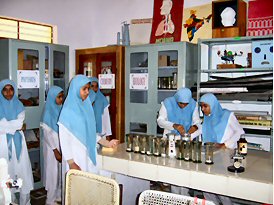 |
1.2 Science Laboratory: this contains quite a lot of science equipment and posters but is too small to accommodate a whole primary class and therefore science teaching takes place mainly in the classroom at primary level. |
1.3 Library: There is currently no library as this classroom is now used to accommodate PUC 2 classes. The library stock consists of a few reference books.
1.4 ICT Suite: This contains 14 computers running Windows 98 Software. One computer in the school has internet access. Primary classes have one practical ICT session per week and one theory lesson.
1.5 Hall: There is also a large prayer room which is also used as a meeting hall. This has a projector which we used during our Inset training sessions.
1.6 Staff have the use of a small staffroom which contains tables and chairs, the Headmistress’s desk and lockers for personal use. There is also a large office which is used for attending to parents and visitors.
1.7 The front courtyard is large and is used for assemblies, with a separate and spacious sports ground in front of the Teachers’ Accommodation, containing a range of nets to support different sports activities. There is also a dedicated play area with swings etc.
2. General Impressions of Teaching and Learning in Primary & Foundation Stage (Lower Kindergarten up to Standard 5)
| The teachers and students all work extremely hard. Students are well behaved and well motivated to learn. There is a high level of concentration. All teachers have a planning book in which they write what lesson they will teach that day and what assignment will be set. |
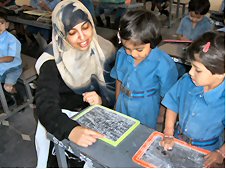 |
The Primary Headmistress visits classes on a daily basis, observing lessons then giving individual feedback to teachers.
One newly trained young teacher in Lower Primary did use a planning format obtained from her formal teacher training to plan her lessons, including resources.
The teaching in the Foundation stage is very interactive in the LKG classes (which has movable plastic tables and chairs and a mat), but less so in the UKG classes as the benches furniture restricts movement. In the Primary classrooms the teaching is generally teacher led with a focus on comprehension type activities. This rote style of teaching and repetition is however very effective in developing memory retention and recall skills. Recall of the times tables and spelling skills even in the lower primary classes was very impressive.
There is some good Primary teaching with teachers having good subject knowledge, a range of auditory and visual activities, using charts or diagrams, sometimes prepared by teachers. One teacher used a simple but effective role play activity to demonstrate the concept of unity. Sometimes however teachers appear to read straight out of a book and appear to depend on this for their teaching, with little attempt at variation.
The KG classes had a lot of printed posters displayed; other Primary classes displayed a few posters or children’s project work. Teachers however had little experience of the use of displays to celebrate children’s work and efforts or as a means of supporting teaching and learning. Teachers are willing to address this but lack the resources necessary to do so.
3. Individual Teacher Observations
Individual teaching observations are carried out on a daily basis by both Primary and Secondary Heads with feedback given to teachers.
I carried out 14 observations of teachers over a range of subjects and classes. Observations were planned for PE and ICT. These however did not take place due to the arrival of the WF Documentary Team which halted lessons for the day. Following this I spoke individually with the ICT teacher, who seemed to have clear long term objectives for each year group’s learning. Teachers were given individual feedback of aspects of good teaching and areas for development. I later shared these observations and feedback with the Head of Primary, which she noted in writing and affirmed.
3.1 Where teaching was good the following was apparent:
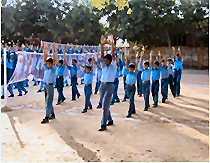 |
Clear explanations; good modelling of work (e.g. layout of mathematical problems); gentle correction and redirection; clear use of voice; a good shared session on the board with examples given; praise used; rephrasing; checking on previous learning; |
positive relationships between teacher and pupils demonstrating good interaction; children keen and motivated to learn; setting of ground rules (I will ask you first then I will choose who to answer); clear instructions given; children given opportunity to be ‘teacher’ in lower primary and lead the rhymes; teacher moved around class to ensure all pupils could hear and were engaged in learning; answers checked collectively on the board with a range of children selected to answer.
3.2 Where teaching was satisfactory the following was apparent:
A lack of preparation; reliance on books; a lack of use of praise for correct responses or efforts; a great deal of teacher talk and teacher led session; no clear ground rules set for answering question in a younger class which led to a lot of enthusiastic simultaneous responses; teacher leading from the front only, with children at the back fiddling or writing and not engaged; unclear reading of information from the book; a lack of validation for effort where answers given were incorrect; monotone voice; closed questioning; only children with hands up were selected to answer questions – others were not challenged.
4. Areas for Improvement – Teaching and Learning
4.1 Clear planning of lessons with consideration given to learning outcome (the aim of the lesson), planned questioning, and shared as well as individual opportunities for learning in lessons.
4.2 Use of a range of questions (open and analytic questions rather than closed comprehension style questioning)
4.3 More practical activities to meet the needs of kinaesthetic learners as well as the visual and auditory through use of visual aids and opportunities for pair/group talk and discussion.
4.4 Use of praise specifically i.e. rather than saying ‘very good’ (which is meaningless) describe what was good about the response - ‘Well done for explaining that so clearly’.
4.5 Use of praise even when the answer is wrong – ‘that was a good effort’.
4.6 ‘Catch children being good’. Use praise to encourage desired behaviour.
4.7 Use children’s names when addressing them rather than ‘you’.
4.8 Planned practical demonstrations in science lessons, with opportunities for students to carry out investigations individually or in groups.
4.9 Use mini-blackboards for shared activities and to enable teacher to check on learning. Chanting answers does not inform the teacher as to which children have achieved a clear understanding and which are simply following chants.
4.10 Where English is being taught, it is imperative that teachers have a clear accent/pronunciation in order to model the spoken language.
| 4.11 Seating – move children around once every term so that those sitting at the back get an opportunity to sit at the front and the middle through the year. Taller children can sit at the outer aisles so as not to obscure the view of the board. |
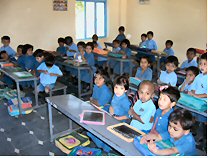 |
4.12 Ensure children with poor concentration or those needing more support are seated near the front to enable teacher to check on their learning and understanding more readily.
4.13 Use of Brain Gym.
5. Areas for Improvement – Whole School
5.1 Obtain 6-8 additional computers so there are at least 20 computers for a class of 40.
5.2 Upgrade all computers to Windows XP.
5.3 Obtain a range of software for different ages and curriculum areas.
5.4 Must have a Library resourced with Reference, Fiction and Non-Fiction books as well as newspapers. Reading for pleasure is an important part of education and improved literacy in all languages.
5.5 Incorporate a timetabled library session for each class.
5.6 Have displays supporting learning as well as celebrating children’s work and efforts in each classroom.
5.7 Science Laboratory should be used more often by the Primary section with more practical demonstrations and opportunities for the students to carry out simple investigations.
5.8 Teachers should award a grade for effort and class participation in progress reports. (Children’s progress needs to be measured in relation to personal progress made as well as in relation to peers).
5.9 Individual teaching observations by Heads to be carried out with a specific focus i.e. quality of questioning, VAK activities etc, with teachers notified beforehand. This will ensure teachers plan lessons with a specific focus, enabling better teaching and learning.
6. Suggestions to Board of Trustees
6.1 Obtain furniture for the Foundation stage classes. Currently only LKG has movable small tables and chairs and a mat that can be used when the tables and chairs are cleared out to the side. The foundation stage – Lower KG, Upper KG A & B require small, coloured tables and chairs which can be grouped together for group activities, or in singles/pairs etc. to enable a range of activities to take place.
6.2 Provide a mat/carpet for whole class shared activities (i.e. story telling) in all KG classes and also Standard 1.
6.3 Provide a CD player in each KG class to enable use of CDs for rhymes etc.
6.4 Create a separate Activity room for LKG/UKG resourced with a variety of practical activities (i.e. home corner, painting corner, sand corner, reading area, water play etc) and a mat.
 |
6.5 Paint all classrooms in bright colours as the walls are now grimy.
6.6 All classes need display boards (one or more) or at least an area painted on the wall in a different colour to demarcate it as a display area. |
6.7 If furniture is to be replaced then wooden rather than steel benches will be more suitable. Ideally LKG – Std 4 to have movable tables instead of benches to enable group work.
6.8 Remove the raised concrete teacher’s platform in every classroom (Health & Safety). This will also make the classrooms more spacious.
6.9 When flooring is replaced, use light coloured tiles to make classrooms brighter and appear more spacious.
6.10 Raise ground floor rooms to prevent flooding during the rains or make other arrangements to stop the classrooms getting flooded.
6.11 Provide a clock with clear Arabic numerals in every classroom.
6.12 Provide mini-blackboards, a class set for every classroom for use in shared activities.
6.13 Provide teaching aids such as unifix cubes etc. necessary in the primary section to support kinaesthetic learning and particularly meet the needs of weaker learners.
6.14 Provide basic stationery to enable more creative activities such as coloured paper, paint, glue, scissors etc. Coloured paper and borders for displays. Blue Tack to put up displays and teaching aids.
6.15 Provide 6-8 computers totalling at least 20 computers per class of 40.
6.16 Upgrade all computers to Windows XP; purchase additional educational software.
6.17 Must have a Library resourced with Reference (Dictionaries and Subject based), Fiction and Non-Fiction books, Newspapers in English, Urdu and Kannada. Reading for pleasure is an important part of learning and essential for improved literacy in all languages. Chairs and a mat/seating area in the library are also needed. A computer with internet access would also enable students to research further.
6.18 Science Room and Prayer Hall space is inadequate to accommodate class size. Please see Sister Selina Kassamali’s report for further details and suggestions.
6.19 Progress reports to be amended to include a grade for effort and class participation.
6.20 Staff wages need to be reviewed and raised as they are currently 40% of Government pay leading to a high staff turnover. An incentive could be offered for Recruitment and Retention i.e. a cumulative bonus paid at the end of every 3 years continuous service. (A pension scheme has already been planned for).
6.21 Overall Leadership – there is a need of a Principal with overall authority and effective communication skills to manage the school and lead future action.
6.22 Must have an on-site nurse or gynaecologist to deal with specific areas of science education and general health issues.
6.23 Ensure recruitment of experienced and knowledgeable Deeniyat teachers to ensure that a sound Religious Education is achieved at all levels of education, but particularly at Primary level where the foundations are being established. Also Qur’anic recitation classes - (as the children attending Zainabiyya School are advised not to attend any other madressa, so all deeniyat needs should be met through the school timetable to a very high level).
6.24 Enable Teacher Training and recruiting of Teachers from Alipur. See 6.25 below.
6.25 There are many bright female students who would like to pursue higher education and acquire teacher training to enable them to teach in Alipur Zainabiyya School. Parents however are not willing to let their daughters leave the village and move alone to town to study. Girls are also generally married at an early age.
6.25.1 One option is to sponsor young married couples, so that the boy could pursue some form of training in a city such as Bangalore at the same time as the girl pursuing higher education and teacher training.
6.25.2 A second option is to employ a part time teacher to support students studying an Open University Degree / Teacher Training in Alipur Zainabiyya School. Crèche facilities could also be provided for the young mothers to enable them to pursue Higher Education if they so wished.
6.25.3 A third option, (although not supported by Alipur parents currently) is to enable girls to study in town (Bangalore) with Hostel Accommodation and a married couple employed to supervise girls ‘In Loco Parentis’.
6.26 There is a central stairwell in the School leading to all floors but no emergency exit/staircase. This could be a Health & Safety issue and needs to be addressed.
7. Inset Training conducted to improve Teaching & Learning in the Primary Section
The first day, Monday was spent meeting teachers, making general observations and having discussions with management.
Tuesday, Wednesday and Thursday were spent carrying out teacher observations in the morning and 3 hour Inset Training sessions in the afternoon. Teachers from the Alipur and Karimpur Zainabiyya schools as well as the Alipur government school attended these sessions.
Training for Primary and Secondary were carried out separately over the first two days.
On Thursday collective joint sessions were planned and delivered with Sister Selina addressing the Effective use of Displays and myself a session on the use of Brain Gym. |
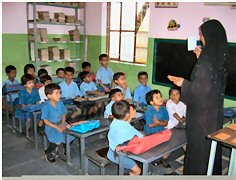 |
A third session on Creative activities had to be cancelled as due to the arrival of the WF Documentary team, morning observation time was cancelled and the Inset was delayed allowing only 1 hour out of the planned 3 hour session.
I conducted Inset sessions on Lesson Planning and Engaging Different learning Styles; Formative and Summative Assessment; Effective use of Questioning in learning; and Brain Gym.
We visited the Karimpur school on Friday as the Alipur school was closed.
7.1 Lesson Planning:
Focussing on how to plan a good lesson with clear objectives and intended learning outcomes, recap, introduction of learning with use of modelling, shared activity, individual activity, plenary and self assessment.
7.2 Learning Styles:
Looking at engaging learners with different learning styles, i.e. Visual, Auditory and Kinaesthetic (VAK). Looking at different activities and tools which could be used to support the range of VAK learning styles. Teachers then worked in groups of four to plan a good lesson with all the above ingredients and then fed back to the class.
7.3 Assessment For and Of Learning (Formative and Summative):
Looking at both assessment OF learning such as tests currently practised at the school, and assessment FOR learning. This involves the use of focus feedback activities at the beginning of lessons to recap and check previous learning, opportunities for paired and group talk, self assessment principles, models of self assessment, peer assessment, defining clear criteria for students to reflect on their learning and thinking about the next steps in learning.
7.4 Effective Questioning for Teaching and Learning:
The focus was on identifying and using a range of questioning as a means of differentiation and formative assessment, and as a tool for enhancing learning and enabling broader thinking in the students. We looked at ‘Blooms Taxonomy’ which classifies the different categories of questions i.e. comprehension, analysis etc, and the types of key words used for each. Teachers were given a handout of these to support them in class and an A3 size copy has also been made to put up in every classroom.
7.5 Brain Gym
A session for all teachers, both Primary and Secondary. We looked at the use of Brain Gym to enhance learning through activating both the Left and the Right brain, enhancing concentration and energising students.
I then demonstrated different Brain Gym activities and teachers had a hugely enjoyable opportunity for a practical session of Brain Gym - saris, abayas and all!
7.6 Classroom Displays
A session for all teachers both Primary and Secondary, conducted by Sister Selina Kassamali and covering the characteristics of a good display. A range of examples were shown to teachers.
8. Meeting with Parents
We requested that parents be invited to a meeting to give us an opportunity to discuss how best they could support their children’s and more specifically their daughters’ education. There was a great turnout with more than a hundred mothers attending.
Both Selina and I spoke to them about the importance of talking to their children about the day’s learning, ensuring regular attendance and punctuality, and understanding the importance of educating daughters. Educating daughters is extremely important for without Sayyida Zainab a.s., after whom the school has been named, there would be no Islam today.
We encouraged the parents to support their extremely able and talented daughters to pursue further education. The parents reacted positively and were in agreement with our suggestions. However they were willing to support further study in Alipur only and not outside of the village.
9. Meeting with Past Graduates of Zainabiyya School, Alipur
We requested an opportunity to meet with past graduates of the school. About 25 young women attended (one young Standard 10 graduate from last year even came with her 3 month old son!).
The girls were bright and interested in studying further. When asked, many were keen to pursue Teacher Training with an aim of teaching in the Zainabiyya School. However early marriage and a lack of support from parents / in-laws seemed to be the greatest obstacle. Parents would also never agree to their going outside Alipur for Higher Education. When asked how interested they would be if the opportunity were made available to pursue an Open University course in Alipur, supported by the school, the majority indicated that they were keen to pursue this option.
10. Meeting with Mawlana from the School Governing Body.
We met with Mawlana to discuss the education in the school. He appeared to support further study for girls beyond PUC.
11. Visit to the Noble Boys’ School, Alipur
This is a boys’ school set up by an independent family trust, with a new four storey building and superb facilities. They follow the Central Board Syllabus. It is imperative that good links with mutual co-operation and sharing of good practise as well as resources is established, as both schools serve the children of the same community with the same aims. (Note: the Noble School also has one central staircase and no emergency exit).
12. Visit to the Karimpur Zainabiyya School
 |
The Karimpur School is built on a similar model to the Alipur School with classes from LKG to Standard 5 currently. |
We met members of the community involved in the administration of the school; their dedication and unity of purpose is to be commended. Class observations could not be carried out as the WF Documentary filming was taking place.
13. Teachers’ Accommodation
We were accommodated in a flat in the Teacher’s Accommodation block. Every effort had been made to ensure our comfort, with new cutlery, crockery, toiletries having been thoughtfully provided. (A brand new packaged fridge was carried in and set up in front of our own eyes!). Meals were prepared according to our taste and fruit was provided in abundance.
The accommodation though basic was comfortable. The only drawbacks were an Indian w.c., no hot water shower, and electricity power cuts for several hours a day.
The opportunity to meet and work with all our sisters and brothers who strive tirelessly to make the Zainabiyya School a success has been a truly humbling and inspiring experience.